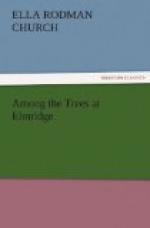“They are certainly found in a great many different places,” was the reply, “and even in the warmest countries. In one of the missionary settlements in Africa there is a solitary willow that has a story attached to it. It was the only tree in the settlement—think what a place that must have been!—except those the missionary had planted in his own garden, and it would never have existed but for the laziness of its owner. Nothing would have induced any of the natives to take the trouble to plant a tree, and therefore the willow had not been planted. But it happened, a long-time ago, that a native had fetched a log of wood from a distance, to make into a bowl when he should feel in the humor to do so. He threw the log into a pool of water, and soon forgot all about it. Weeks and months passed, and he never felt in the humor to work. But the log of wood set to work of its own accord. It had been cut from a willow, and it took root at the bottom of the pool and began to grow. In the end it became a handsome and flourishing tree.”
This story was approved by the young audience, except that it was too short; but their governess laughingly said that, as there was nothing more to tell, it could not very well be any longer.
[Illustration: THE WEEPING WILLOW (Salix Babylonica).]
“The weeping willow,” continued Miss Harson, “was first planted in England in not so lazy a way, but almost as accidentally. Many years ago a basket of figs was sent from Turkey to the poet Pope, and the basket was made of willow. Willows and their cousins the poplars are natives of the East; you remember that the one hundred and thirty-seventh psalm says of the captive Jews, ’By the rivers of Babylon, there we sat down, yea, we wept, when we remembered Zion. We hanged our harps upon the willows in the midst thereof.’ ’The poet valued highly the small slender twigs, as associated with so much that was interesting, and he untwisted the basket and planted one of the branches in the ground. It had some tiny buds upon it, and he hoped he might be able to rear it, as none of this species of willow was known in England. Happily, the willow is very quick to take root and grow. The little branch soon became a tree, and drooped gracefully over the river in the same manner that its race had done over the waters of Babylon. From that one branch all the weeping willows in England are descended.’”
“And then they were brought over here,” said Malcolm. “But what odd leaves they have, Miss Harson!—so narrow and long. They don’t look like the leaves of other trees.”
“The leaf is somewhat like that of the olive, only that of the olive is broader. The willow is a native of Babylon, and the weeping willow is called Salix Babylonica. It was considered one of the handsomest trees of the East, and is particularly mentioned among those which God commanded the Israelites to select for branches to bear in their hands at the feast of tabernacles. Read the verse, Malcolm—the fortieth of the twenty-third chapter of Leviticus.”




